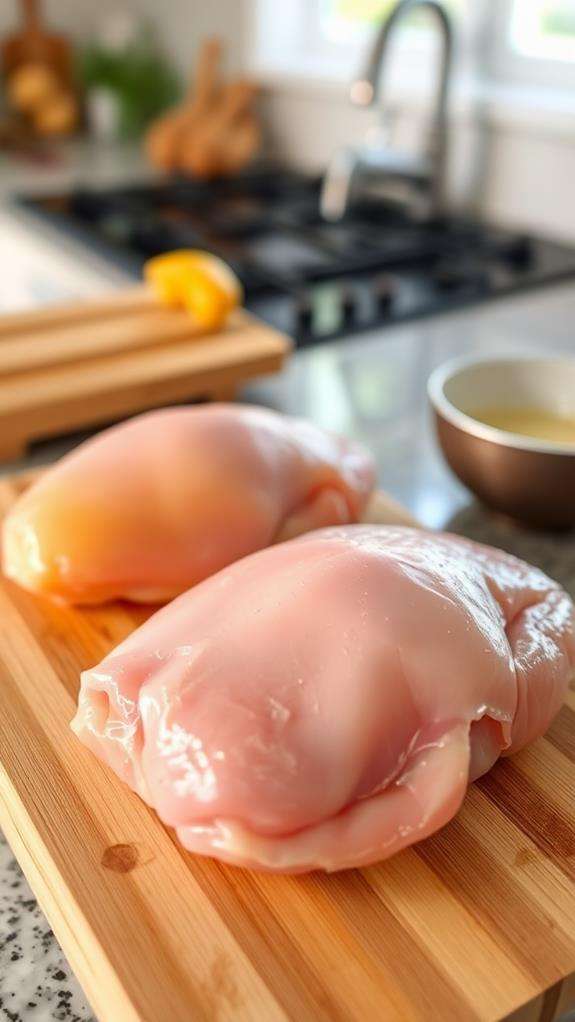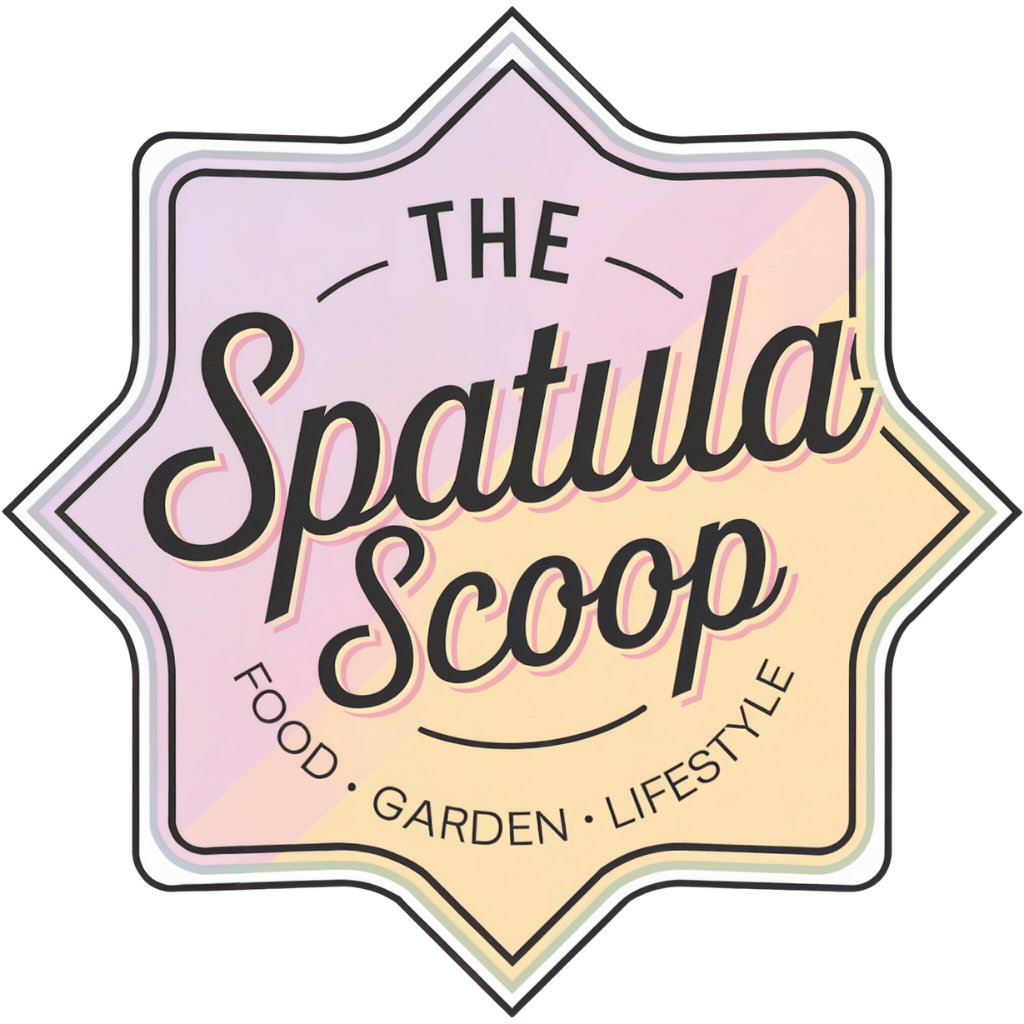Is Yellow Chicken Safe to Eat
Yellow chicken is generally safe to eat, but color alone isn't a reliable indicator of safety. The yellow hue can result from the chicken's diet, breed, or processing methods. When evaluating safety, you should focus on other factors like smell, texture, and expiration date. Look for signs of spoilage such as off-odors, slimy texture, or discoloration beyond the yellow tint. Proper storage and cooking are indispensable: keep raw chicken below 40°F and cook it to an internal temperature of 165°F. If you're unsure about the chicken's safety, it's best to err on the side of caution and discard it. Understanding the full picture of chicken safety involves more than just color.
This post may contain affiliate links. If you make a purchase through these links, I may earn a commission at no additional cost to you. Additionally, portions of this post may be generated using artificial intelligence (AI) technology. While we strive for accuracy, please be aware that AI-generated content may not always be perfect and should be fact-checked when necessary.
The Spatula Scoops
- Yellow chicken is generally safe to eat if the color is due to feed ingredients or natural factors.
- Safety depends on proper storage, handling, and cooking, not the yellow color itself.
- Cook chicken to an internal temperature of 165°F to ensure it's safe, regardless of color.
- Check for signs of spoilage like off-odors, slimy texture, or discoloration beyond yellow.
- Yellow fat in chicken is often normal and doesn't indicate spoilage or safety issues.
Causes of Yellow Chicken

Yellow-tinged chicken can result from several factors in the bird's diet and processing. One common cause is the inclusion of marigold petals or other yellow-pigmented ingredients in chicken feed. These additives contain carodenoids, natural pigments that can transfer to the chicken's fat and skin. You'll often see this in free-range or organic chickens, where varied diets are more common. While yellow chicken is generally safe, it's essential to make certain it reaches the proper internal temperature to eliminate harmful bacteria.
Another factor is the chicken's age and breed. Older birds and certain breeds naturally have more yellow fat. During processing, if the chicken isn't chilled quickly enough, this yellow fat can seep into the meat, causing discoloration. Additionally, the use of certain antibiotics or medications in poultry farming can sometimes lead to yellowing.
It's important to note that yellow chicken isn't necessarily unsafe. However, if you're concerned about food safety, always check for other signs of spoilage like off-odors or slimy texture. When in doubt, it's best to consult with the retailer or a food safety expert. Remember, proper cooking and handling practices are vital for ensuring your chicken is safe to eat, regardless of its color.
Safety Considerations
While the color of chicken can vary, safety should always be your top priority. When dealing with yellow chicken, you'll want to ponder several factors beyond just its hue. First, check the chicken's smell. If it has a sour or unpleasant odor, it's best to discard it. Next, examine the texture. Slimy or sticky chicken is a red flag, indicating potential bacterial growth. It's indispensable to be aware of the danger zone for bacterial growth, which is between 40°F and 140°F. Leaving chicken at room temperature for extended periods dramatically increases the risk of foodborne illness.
You should also ponder the chicken's source and storage. If you're unsure about its origin or how it's been handled, err on the side of caution. Always store chicken at the proper temperature, below 40°F (4°C), to prevent bacterial proliferation. When cooking, guarantee the internal temperature reaches 165°F (74°C) to kill harmful bacteria.
How to Identify Spoilage

Identifying spoilage in chicken is essential for food safety. You'll need to use your senses to detect any signs of deterioration. Here's a table to help you recognize spoiled chicken:
| Sense | Fresh Chicken | Spoiled Chicken |
|---|---|---|
| Sight | Pink, no discoloration | Gray, green, or moldy patches |
| Smell | Mild or no odor | Sour, rotten, or sulfuric |
| Touch | Firm, slightly moist | Slimy, sticky texture |
| Packaging | Intact, no bloating | Bulging, leaking |
| Date | Within use-by date | Past expiration date |
When examining your chicken, look for any unusual colors or textures. Fresh chicken should have a light pink hue and feel slightly moist but not slimy. If you notice a strong, unpleasant odor, it's likely spoiled. Don't rely solely on the expiration date, as improper storage can cause spoilage before this time. If the packaging is bloated or leaking, it's a sign of bacterial growth. Trust your instincts – if something seems off, it's better to be safe and discard the chicken. Remember, consuming spoiled chicken can lead to foodborne illnesses, so it's paramount to be vigilant in your inspection.
Proper Chicken Storage Techniques
To safeguard your chicken stays fresh and safe to consume, essential storage methods are crucial. First, ensure you refrigerate raw chicken promptly, ideally within two hours of purchase or one hour if the temperature exceeds 90°F (32°C). Store it in the coldest part of your fridge, typically the bottom shelf, at a temperature below 40°F (4°C). It's vital to use a reliable thermometer to verify your refrigerator maintains this safe temperature consistently.
When storing chicken, use airtight containers or sealed plastic bags to prevent cross-contamination with other foods. If you're not planning to use the chicken within a day or two, consider freezing it. For optimal freshness, wrap the chicken tightly in freezer paper or plastic wrap, then place it in a freezer bag, removing as much air as possible.
Label your stored chicken with the date of purchase or freezing to track its shelf life. Raw chicken can be safely stored in the refrigerator for 1-2 days and in the freezer for up to 9 months. When thawing frozen chicken, do so in the refrigerator, never at room temperature. This slow thawing process helps maintain the chicken's quality and prevents bacterial growth. By following these storage techniques, you'll ensure your chicken remains safe for consumption and maintains its quality.
Cooking Yellow Chicken Safely

The color conundrum of yellow chicken often raises safety concerns among home cooks. If you've noticed a yellowish tint to your poultry, don't panic. While it's crucial to be cautious, yellow chicken isn't always unsafe to eat. The key lies in proper cooking techniques and temperature control.
First, make certain you're using a reliable meat thermometer. Insert it into the thickest part of the chicken, avoiding bones. The internal temperature should reach 165°F (74°C) to kill harmful bacteria. If your chicken is yellow but properly cooked, it's generally safe to consume.
However, if the yellowish color is accompanied by a foul odor or slimy texture, it's best to discard the meat. These are signs of spoilage, regardless of color. When cooking yellow chicken, pay extra attention to food safety practices. Use separate cutting boards for raw and cooked meats, wash your hands frequently, and avoid cross-contamination. Remember, color alone isn't a definitive indicator of safety or doneness. Trust your thermometer and your senses. If you're ever in doubt about the safety of your chicken, it's better to err on the side of caution and throw it out.
Frequently Asked Questions
Can Yellow Chicken Affect the Taste or Texture of the Meat?
Yes, yellow chicken can affect both the taste and texture of the meat. You'll likely notice a difference in flavor, as it may have a slightly rancid or off-taste. The texture can also be affected, potentially becoming softer or mushier than normal. These changes occur due to the chemical processes that cause the yellowing. It is crucial to recognize that these alterations in taste and texture are often signs that the chicken may not be safe for consumption.
Are There Any Nutritional Differences Between Yellow and Regular Chicken?
Did you know that yellow chicken isn't actually a different breed? It's just regular chicken with a yellow hue. Nutritionally, there aren't significant differences between yellow and regular chicken. The yellow color comes from the chicken's diet, often rich in corn or marigold petals. This doesn't affect the protein, fat, or vitamin content. You'll get the same nutritional benefits from both types. The main difference is purely aesthetic, so don't worry about choosing one over the other for health reasons.
Can Yellow Chicken Be Used in All Recipes Calling for Chicken?
You can use yellow chicken in most recipes that call for regular chicken. It's versatile and adaptable, so you'll find it works well in various dishes. However, keep in mind that yellow chicken might have a slightly different flavor profile due to its diet. This could subtly affect the taste of your final dish. When cooking, you may want to adjust seasonings or marinades to complement the potentially richer flavor of yellow chicken. Always confirm it's thoroughly cooked to maintain food safety.
Is Yellow Chicken More Common in Certain Breeds or Farming Practices?
You might think yellow chicken is as common as the sun in the sky, but it's not quite that widespread. Yellow chicken isn't more common in specific breeds or farming practices. It's actually a result of the chicken's diet, particularly when they're fed corn or marigold petals. This can happen in various breeds and farming systems. The yellow color comes from carotenoids in the feed, which accumulate in the chicken's fat. It's not a breed-specific trait or a farming practice indicator.
Does Yellow Chicken Have a Different Shelf Life Than Regular Chicken?
You might wonder if yellow chicken has a different shelf life than regular chicken. Generally, the color doesn't affect how long it'll stay fresh. The shelf life depends more on factors like storage conditions and processing methods. Whether your chicken is yellow or not, you should follow the same safety guidelines. Store it in the refrigerator at 40°F or below and use it within 1-2 days of purchase. For longer storage, freeze it at 0°F or below for up to 9 months.
Conclusion
While yellow chicken might raise eyebrows, it's often safe to eat if properly handled and cooked. You've learned about causes, safety considerations, and spoilage signs. Remember, proper storage is essential. Whether your chicken is yellow or not, always cook it thoroughly to an internal temperature of 165°F (74°C). By staying informed and following food safety guidelines, you can enjoy your chicken dishes without worry. When in doubt, it's best to err on the side of caution and discard suspicious poultry.





